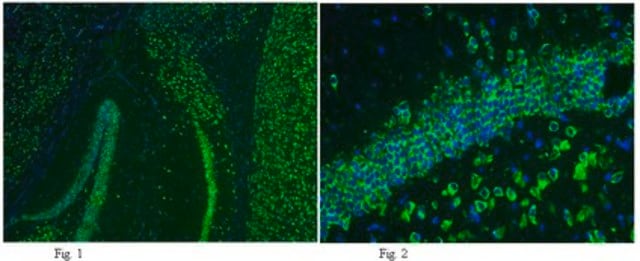MAB397
Anti-Glutamate Receptor 2 Antibody, extracellular, clone 6C4
clone 6C4, Chemicon®, from mouse
Synonym(s):
GluR2
About This Item
Recommended Products
biological source
mouse
Quality Level
antibody form
purified immunoglobulin
antibody product type
primary antibodies
clone
6C4, monoclonal
species reactivity
monkey
species reactivity (predicted by homology)
mouse, rat, canine
manufacturer/tradename
Chemicon®
technique(s)
ELISA: suitable
immunocytochemistry: suitable
immunohistochemistry: suitable
immunoprecipitation (IP): suitable
radioimmunoassay: suitable
western blot: suitable
isotype
IgG2a
NCBI accession no.
UniProt accession no.
target post-translational modification
unmodified
Gene Information
dog ... Gria2(482667)
mouse ... Gria2(14800)
rat ... Gria2(29627)
rhesus monkey ... Gria2(574344)
General description
Specificity
Application
on 4% paraformaldehyde fixed cells was used in a previous lot:2-3 µg/mL (Vissavajjhala, 1996; Osten, 1998; Passafaro, 2001).
ELISA/RIA:
A previous lot of this antibody was used in ELISA/RIA.(Vissavajjhala, 1996).
Immunohistochemistry on 50 µm, 4% paraformaldehyde fixed brain sections: 1:500-1:800 (Vissavajjhala, 1996; Yung, 1998; Kumar; 2002).
Immunoprecipitation: 2-4 µg/mL (Osten, 1998).
Western blot: 1-2 µg/mL (Vissavajjhala, 1996; Osten, 1998); membrane preparations are suggested for enhanced signals.
Optimal working dilutions and protocols must be determined by end user.
Quality
Western Blot Analysis:
1:1000 dilution of this lot detected glutamate receptor 2 on 10 μg of mouse brain lysates.
Target description
Physical form
Storage and Stability
Handling Recommendations: Upon receipt, and prior to removing the cap, centrifuge the vial and gently mix the solution. Aliquot into microcentrifuge tubes and store at -20°C. Avoid repeated freeze/thaw cycles, which may damage the IgG2a and affect product performance.
Analysis Note
Positive Control: Cerebral cortex and pyramidal neurons, mouse brain lysate.
Other Notes
Legal Information
Not finding the right product?
Try our Product Selector Tool.
recommended
Storage Class
12 - Non Combustible Liquids
wgk_germany
WGK 2
flash_point_f
Not applicable
flash_point_c
Not applicable
Certificates of Analysis (COA)
Search for Certificates of Analysis (COA) by entering the products Lot/Batch Number. Lot and Batch Numbers can be found on a product’s label following the words ‘Lot’ or ‘Batch’.
Already Own This Product?
Find documentation for the products that you have recently purchased in the Document Library.
Our team of scientists has experience in all areas of research including Life Science, Material Science, Chemical Synthesis, Chromatography, Analytical and many others.
Contact Technical Service







